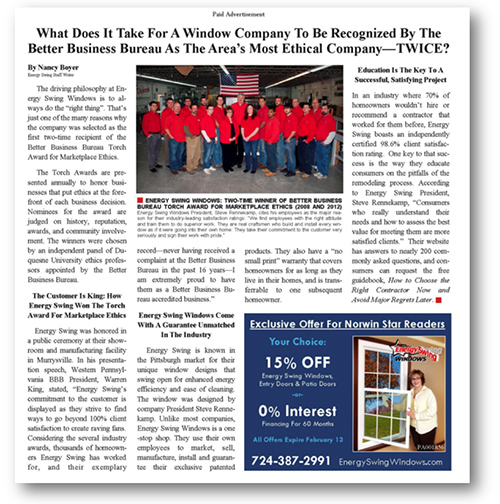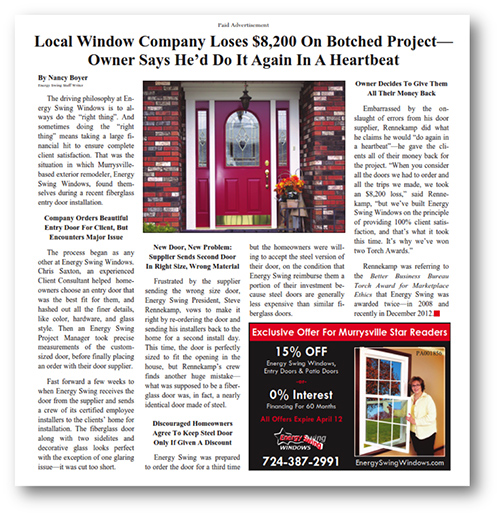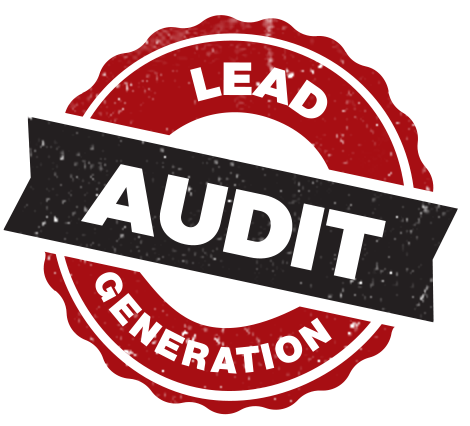NOBODY CARES.
How We Rewrote An Advertorial So People Were Interested
Enough To Read It, Believe It, And Take Action On It.
Written by Rich Harshaw
Sometimes I feel like one of those doctors who has to deliver bad news to nervous families in waiting rooms.
In this case, the bad news was delivered to client Steve Rennenkamp, who had just been awarded the BBB’s coveted “Torch Award” for the second time. As you’re probably aware, this is a pretty big deal—they don’t just hand out these awards to anyone. They are earned, which is why Steve wanted to use it in his contractor marketing efforts. So to capitalize on his second award in four years, Steve wrote an advertorial (newspaper ad that looks like an article) talking about his achievement.
Here’s the original ad:
It’s a pretty straightforward discussion of what they won and what their business philosophy is. Good enough, right?
Wrong.
My blunt response to the ad: “I’m sorry Steve. I’m glad that your company won the BBB Torch Award for the second time. But I hate to tell you—nobody cares. It’s boring.”
Talk about informing the family that the patient won’t survive.
The fatal flaw with the ad is that as an article (remember, it’s an advertorial), it doesn’t even come close to covering information that anyone gives a proverbial rat’s butt about. To remain relevant, newspapers (and other media outlets), must provide their audience with credible, timely, and interesting content. Advertisers, on the other hand, are frequently more focused on delivering their selling points, which leads to content that’s not very engaging. This ad sounds like it was written by and for employees of Steve’s company—not for the readers.
The above critique isn’t just for advertorials, either. It’s just as true for a “traditional” ad as well.
I challenged Steve to find a way to reposition the Torch Award—instead of telling people THAT he won it, help them understand WHAT THEY DID that allowed them to be eligible for it.
Since the Torch Award is given to businesses that “put ethics at the forefront of business decisions,” I asked Steve to give me a concrete example of a time when his company did just that. I challenged him to think of a real-life situation where it would have been easier & cheaper to cut losses and walk away… but where they instead specifically decided to do the go above and beyond the call of duty, ethics-wise.
Immediately he started telling me a story about a time when their supplier messed up a door order TWO times in a row—first by cutting it too short, then by sending it in the wrong material (steel instead of fiberglass). The client was upset, but agreed to sign off on the second door as long as Steve would give him a big discount. Instead, Steve ordered and installed the RIGHT door—on the 3rd attempt—then REFUNDED ALL the client’s money. Every penny of it. Between the lost labor, the messed up doors, and the customer refund, they took an $8,200 loss on the project.
Now THAT’S a story!
I told Steve all he had to do was tell that story in the ad; then I helped him write this headline and copy below:
Now this is a story that people will actually read in the newspaper!
Getting noticed… getting people to pay attention… getting people to get engaged in your message—that’s 90% of the battle. When you accomplish that, very good things happen.
In Steve’s case, it paid off in leads and sales.
The Results:
- They ran the revised ad in the Murrysville Star in January, 2013 at a cost of $4,000.
- The ad returned over $50,000 in sales. That’s an ROI of 12 to 1.
- They had spent the same amount of money on “traditional” ad placements in the same newspaper and barely even received a phone call.
- The prospects who called after reading the article stated they felt they could trust Steve’s company more than other contractors.
- The lead quality was significantly better, too—they were able to close the leads at a rate of 50% to 60%, double their usual closing ratio of about 30%
When sitting down to write an ad, think about the reader. Think about the prospect. Think about what they would consider interesting, relevant, and timely. Don’t shove your company bullet points down their throats.
In the end, the patient didn’t die—he just needed to approach the situation from a different angle.
© 2014 – 2016, Rich Harshaw. All rights reserved.










